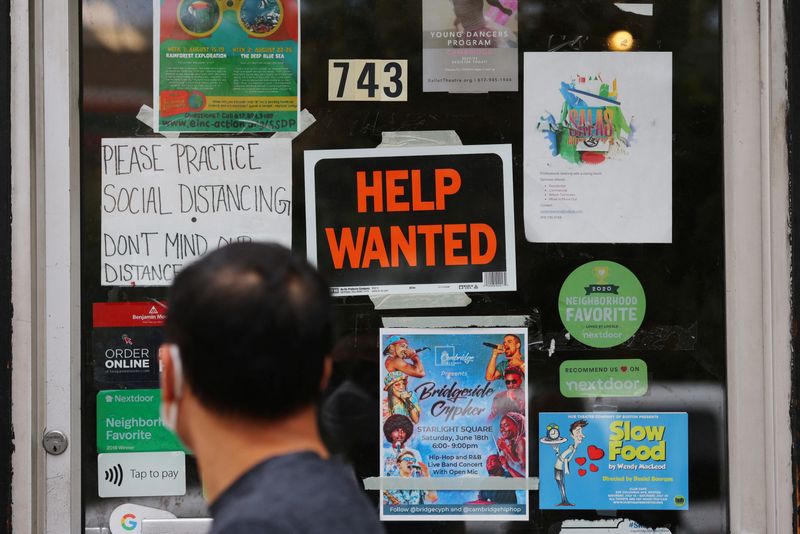Markets labor under recession cloud

FILE PHOTO: A pedestrian passes a «Help Wanted» sign in the door of a hardware store in Cambridge, Massachusetts, U.S., July 8, 2022. REUTERS/Brian Snyder
US500
+0.36%
Add to/Remove from Watchlist
Add to Watchlist
Add Position
Position added successfully to:
Please name your holdings portfolio
Type:
BUY
SELL
Date:
Amount:
Price
Point Value:
Leverage:
1:1
1:10
1:25
1:50
1:100
1:200
1:400
1:500
1:1000
Commission:
Create New Watchlist
Create
Create a new holdings portfolio
Add
Create
+ Add another position
Close
CAG
+0.29%
Add to/Remove from Watchlist
Add to Watchlist
Add Position
Position added successfully to:
Please name your holdings portfolio
Type:
BUY
SELL
Date:
Amount:
Price
Point Value:
Leverage:
1:1
1:10
1:25
1:50
1:100
1:200
1:400
1:500
1:1000
Commission:
Create New Watchlist
Create
Create a new holdings portfolio
Add
Create
+ Add another position
Close
(Refiling to fix formatting issue.)
A look at the day ahead in U.S. and global markets from Mike Dolan.
If the tight U.S. labor market is finally unwinding, markets suspect the Federal Reserve’s job may well done after all — but at the cost of a looming recession.
With Wednesday’s private sector jobs reading for March and Friday’s national payrolls report ahead, U.S. interest rate markets were jolted again on Tuesday by surprisingly soft data on job vacancies that suggested cooling demand for staff.
U.S. job openings dropped to their lowest level in nearly two years in February, with 1.7 job openings for every unemployed person down significantly from 1.9 in January — a ratio watched very closely by the Fed.
Futures markets that had been leaning toward one last Fed hike to 5.0-5.25% next month turned equivocal afterwards and are split 50-50 again on whether further tightening will happen at all — and now pencil in more than 60bps of easing by yearend.
More decisively, the two-year Treasury yield plunged more than 20 basis points intraday to hover just above 3.8% on Wednesday. The dollar swooned to lowest in more than two months.
Many Fed officials doubt the game is won yet, however.
Although not a voting policymaker this year, Cleveland Fed chief Loretta Mester said late Tuesday she rates moving «somewhat further into restrictive territory this year, with the fed funds rate moving above 5% and the real fed funds rate staying in positive territory for some time.»
And that underlines one of the puzzles markets are grappling with. If the Fed was indeed done and dusted with headline consumer price inflation still at 6%, then the real inflation-adjusted Fed policy rate would be peaking in negative territory.
Even getting it positive would have to assume further significant disinflation while the Fed at least holds rates high for months — all of which is slightly at odds with market pricing.
But a more aggressive Fed from here — especially in light of the March banking stress — then raises big recession concerns and stocks have wobbled as that comes back on the radar.
After four straight daily gains to 6-week highs, the S&P500 pulled back half a percent on Tuesday and futures were slightly in the red again.
Even though rotation into so-called ‘quality’ mega cap stocks has buoyed the index, overall valuations are still considered by many as too pricey to account for recession. And full-year S&P500 earnings growth estimates for 2023 turned negative for the first time this week.
The recession monitors are still foggy around the world, however. While manufacturing surveys earlier in the week showed factories on the back foot, service sector soundings on Wednesday were more upbeat, even if below early month readouts in Europe and uneven across countries.
German industrial orders for February surprised on the upside, but engineering orders fell.
And in a sign that not all central banks think the coast is clear yet, the Reserve Bank of New Zealand raised its policy interest by 50 bps to a 14-year high of 5.25%, shattering market expectations for a more modest 25 bp hike.
In geopolitics, attention was on deteriorating Sino-U.S. relations.
Taiwanese President Tsai Ing-wen is set to meet U.S. House Speaker Kevin McCarthy on Wednesday in the first such meeting on U.S. soil, a plan that has drawn threats of retaliation from China, which claims self-ruled Taiwan as its own.
In banking, UBS executives told shareholders the unexpected takeover of Swiss rival Credit Suisse in the biggest bank rescue since the global financial crisis was a milestone for the industry and a major challenge for the bank.
Key developments that may provide direction to U.S. markets later on Wednesday:
* U.S. ADP March private sector jobs report, U.S. and global March service sector surveys, U.S. Feb trade report
* IMF releases chapters of Global Financial Stability report
* European Central Bank chief economist Philip Lane speaks
* U.S. House Speaker Kevin McCarthy scheduled to meet Taiwan President Tsai Ing-wen
* European Commission President Ursula von der Leyen and French President Macron in China
* U.S. corporate earnings: Conagra Brands (NYSE:CAG)
GRAPHIC: https://www.reuters.com/graphics/USA-STOCKS/gkvlwbrrgpb/jolts.png
GRAPHIC: https://www.reuters.com/graphics/USA-RATES/FEDWATCH/mopakymmkpa/chart_eikon.jpg
GRAPHIC: https://www.reuters.com/graphics/NEWZEALAND-ECONOMY/zgvobjwanpd/chart.png
(By Mike Dolan, Editing by Bernadette Baum; mike.dolan@thomsonreuters.com. Twitter: @reutersMikeD)



